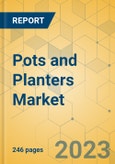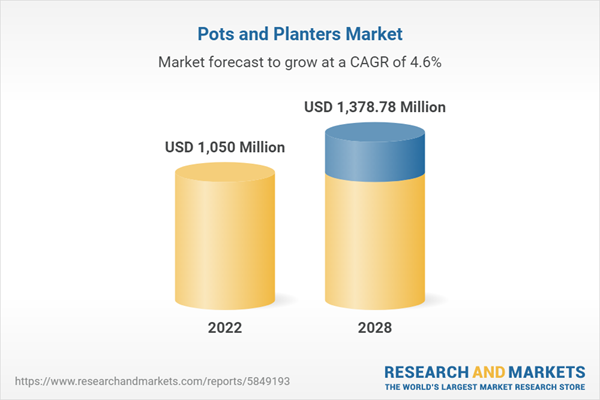Speak directly to the analyst to clarify any post sales queries you may have.
MARKET TRENDS & DRIVERS
Growing Adoption of Vertical Gardens
Vertical gardens are increasingly popular for large installations such as apartment buildings, public spaces, and commercial properties. Vertical gardens are one of the best methods to bring nature into urban sector spaces. They offer a wide range of benefits, such as it helps in lowering air pollution since plants filter out dangerous toxins, and they can help improve biodiversity since they offer habitats to various creatures. In cities planting trees is a great way to help safeguard the environment and make it a more pleasant place to live. They can also help lower stress, providing a peaceful and calming atmosphere. Various vertical gardens are available, each providing an exclusive way to grow plants in confined, small spaces. Hydroponic vertical gardens are one of the most common vertical gardens, as instead of soil, they use nutrient-rich water to allow plants to thrive.Increasing Commercial Construction Activities
The global construction industry is witnessing new developments and market trends. Moreover, technological transformation is a major factor influencing this growth, along with significant changes in design and installation. The growing population, rising demand for public construction activities, and growing investments in renewables and telecommunication are expected to fuel the growth of the construction industry during the forecast period. The commercial sector is witnessing constant growth since 2021 with the reopening of the economy. The construction of hotels, amusement parks, private & government offices, and sports & convention centers is growing, supporting the pots and planters market.INDUSTRY RESTRAINTS
Variability in Raw Material Prices
Raw material costs comprise 50−60% of the overall cost of production. The quality and lifespan of pots and planters heavily depend on the materials and key raw materials used in designing pots and planters to ensure the product's safety. The prices of major raw materials used to manufacture pots and planters, such as plastic and steel, have been volatile over the last few years. The volatility of raw material prices seriously threatens vendor margins in the global pots and planters market. Other operating expenses, such as labor costs, are also sharply increasing. Chinese manufacturers add more uncertainties to the company’s top line. These factors burden vendors striving to produce efficient pots and planters at affordable costs to cope with the competition in the industry.SEGMENTATION INSIGHTS
INSIGHTS BY MATERIAL TYPE
The plastic material type segment is expected to be the largest in the global pots and planters market, accounting for over 28% share in 2022. Plastic pots and planters are available in various shapes, sizes, and colors. There are several types of plastic pots and planters. Low-density polyethylene (LDPE) pots, high-density polyethylene (HDPE) pots, high-impact polystyrene (HIPS) pots, and polypropylene (PP) pots. During the forecast period, the plastic pots and planters segment is expected to gain a significant industry share by catering to the consumer base that earlier preferred clay pots. Several factors have boosted and are still boosting the demand for plastic pots and planters across the globe. The housing sector is gradually gaining traction, and the total demand for housing materials and products is increasing. Plastic pots and planters are available in various shapes, sizes, and colors.Segmentation by Material Type
- Plastic
- Ceramic
- Wood
- Metal
- Concrete
- Fiberglass
- Others
INSIGHTS BY APPLICATION
The global pots and planters market by application is segmented into residential, commercial, and others. Presently, homeowners increasingly prefer to design ornamental gardens with lush flora and fauna and fancy pots and planters. Nowadays, with people using pots of different types, gardening is much more than a hobby to enhance the décor of balconies, windows, open spaces, and terraces. Sales of pots and planters are booming in the household sector and are projected to keep growing. The industry outlook is strong in the residential sector, and buyers of all ages are keen to bring green goods home. Also, household pots and planters create a highly visible online presence that has helped build momentum in pots and planters sales.Segmentation by Application
- Residential
- Commercial
- Others
INSIGHTS BY DISTRIBUTION CHANNEL
The offline distribution channel segment dominated the global pots and planters market in 2022. Offline sales of pots and planters were higher than online sales as consumers prefer to shop for pots and planters in person due to the need for more awareness of the types and sizes of pots. This segment constitutes supermarkets, hypermarkets, and discounters such as Walmart, Lowe’s, Costco, Sears, Tesco, Home Depot, and Target, which sell various types of products. Factors such as broader reach in areas that lack better connectivity and high consumer trust associated with personally experiencing the quality of products are driving the growth of this segment.Segmentation by Distribution Channel
- Offline
- Online
GEOGRAPHICAL ANALYSIS
The global pots and planters market is highly developed in Europe, North America, and APAC owing to the increasing economic development, construction sectors, and tourism sector contributing to the growth of the pots and planters market. On the other hand, Latin America and the Middle East are highly potential markets that help manufacturers to expand their product segments, thereby increasing sales. In 2022, Europe dominated the global pots and planters market. The high demand is attributed to the increased demand for landscaping services due to the widespread green areas across the region. Further, Nordic countries are driving the rapid growth of pots and planters in the next five years. The demand can also be more significant in Western Europe than in Eastern Europe due to the rapid rate of renovation and infrastructure development activities.Segmentation by Geography
- Europe
- Germany
- The U.K.
- France
- Italy
- Spain
- North America
- The U.S.
- Canada
- APAC
- China
- India
- Japan
- Australia
- South Korea
- Latin America
- Brazil
- Mexico
- Middle East and Africa
- Saudi Arabia
- UAE
- South Africa
COMPETITIVE LANDSCAPE
The global pots and planters market is highly fragmented, with many local and international players. The market is characterized by diversified international vendors and a few regional vendors. Prominent players in the market include The HC Companies, Nursery Supplies, East Jorden Plastics, Poppelmann, and Keter. Manufacturers stress effective ways in which new goods are introduced to produce, assemble, and sell while satisfying customers’ different needs and requirements. Major vendors distribute their products via dealers, distributors, mass retailers, and online channels. In addition, these vendors focus on establishing a close partnerships with retailers of pots and planters.Key Company Profiles
- The HC Companies
- Nursery Supplies
- Poppelmann
- Keter
- East Jordan Plastics
Other Prominent Vendors
- Landmark Plastic
- Planters Unlimited
- elho
- Ado
- Amop Synergies
- ATECH
- Novelty Manufacturing
- Vertical Green
- Sereno
- T.O. Plastics
- Anderson Pots
- Garant
- Garden Needs
- Hosco
- Kingfisher Direct
- The Good Pot Co.
- Horst Brandstatter Group
- Scheurich
- Yorkshire Flowerpots
- Stefanplast
KEY QUESTIONS ANSWERED:
1. How big is the pots and planters market?2. What is the growth rate of the global pots and planters market?
3. Which region dominates the global pots and planters market share?
4. What are the significant trends in the pots and planters industry?
5. Who are the key players in the global pots and planters market?
Table of Contents
Companies Mentioned
- The HC Companies
- Nursery Supplies
- Poppelmann
- Keter
- East Jordan Plastics
- Landmark Plastic
- Planters Unlimited
- elho
- Ado
- Amop Synergies
- ATECH
- Novelty Manufacturing
- Vertical Green
- Sereno
- T.O. Plastics
- Anderson Pots
- Garant
- Garden Needs
- Hosco
- Kingfisher Direct
- The Good Pot Co.
- Horst Brandstatter Group
- Scheurich
- Yorkshire Flowerpots
- Stefanplast
Methodology
Our research comprises a mix of primary and secondary research. The secondary research sources that are typically referred to include, but are not limited to, company websites, annual reports, financial reports, company pipeline charts, broker reports, investor presentations and SEC filings, journals and conferences, internal proprietary databases, news articles, press releases, and webcasts specific to the companies operating in any given market.
Primary research involves email interactions with the industry participants across major geographies. The participants who typically take part in such a process include, but are not limited to, CEOs, VPs, business development managers, market intelligence managers, and national sales managers. We primarily rely on internal research work and internal databases that we have populated over the years. We cross-verify our secondary research findings with the primary respondents participating in the study.

LOADING...
Table Information
| Report Attribute | Details |
|---|---|
| No. of Pages | 246 |
| Published | July 2023 |
| Forecast Period | 2022 - 2028 |
| Estimated Market Value ( USD | $ 1050 Million |
| Forecasted Market Value ( USD | $ 1378.78 Million |
| Compound Annual Growth Rate | 4.6% |
| Regions Covered | Global |
| No. of Companies Mentioned | 25 |









